 Oilseeds are important as are the pulses in the country. The principal oilseeds include groundnuts, rapeseeds and mustard seeds. While the former is a kharif crop, depending wholly upon reasonable but timely rainfall, the latter is a rabi crop, fundamentally confined only to non-irrigated areas. As a result their production as well as productivity is subject to climatic variations and market hypotheses. The other oilseeds incorporate sesame, linseed, caster seed, safflower seed, soybeans, sunflower seeds, cotton seeds and copra. Rapeseeds and mustard seeds belong to the wheat belt of north and central India. Groundnut, on the other hand, is grown in west and south India. Gujarat is the dominant producer of groundnut. While population has been mounting at 2 per cent per annum, the demand for oil has been rising at 5 per cent every year.
Oilseeds are important as are the pulses in the country. The principal oilseeds include groundnuts, rapeseeds and mustard seeds. While the former is a kharif crop, depending wholly upon reasonable but timely rainfall, the latter is a rabi crop, fundamentally confined only to non-irrigated areas. As a result their production as well as productivity is subject to climatic variations and market hypotheses. The other oilseeds incorporate sesame, linseed, caster seed, safflower seed, soybeans, sunflower seeds, cotton seeds and copra. Rapeseeds and mustard seeds belong to the wheat belt of north and central India. Groundnut, on the other hand, is grown in west and south India. Gujarat is the dominant producer of groundnut. While population has been mounting at 2 per cent per annum, the demand for oil has been rising at 5 per cent every year.
Oilseeds are raised in almost all the parts of the country. Interestingly, in some regions of the country, they are considered as important oil-seeds. Oilseeds are the source of oil-cake as well as vegetable oil. However, the export of oilseeds has been curtailed to meet the increasing demands of the country. In the year 1950-51, area under groundnut was 4.5 million hectares. By 1996-97 it shot up to 7.8 million hectares. And production too rose to 9 million tonnes from 3.4 million tonnes. The same is true of produce per hectare, which stood at 1155 kg per hectare, against the figure of 775. The story of rabi oilseeds, namely rapeseed and mustard is likewise heartening. The region during this period rose to 6.8 million hectares from mere 2 million hectares, and production from 0.7 million tonnes to almost 7 million tonnes- a ten times ascend. The yield also increased from 368 kg to 1013 kg per hectare. The overall production of nine oilseeds rose to nearly 25 million tonnes by 1996-97. In order to reduce imports of palm oil, plantation of oil palm trees is now being undertaken on a larger scale.
Groundnut is one of the main oilseeds of India. In fact, it is the leading producer in the world. Tropical climates are considered favourable for the growth of groundnuts. This oilseed is raised as a kharif crop. It is not grown mainly in the winter season. Growth of groundnuts is extremely high if sown in well-drained sandy loams. The main months when it is sown are June and July. Gujarat is the main producer of groundnut in India. Other important groundnuts states of the India are Andhra Pradesh, Maharashtra and Tamil Nadu.
Mustard is another significant oil-seed in India. It is cultivated mainly in winter season. They are mainly cultivated as rabi crop. They are grown as mixed crop with gram and wheat. Uttar Pradesh and Rajasthan are the principal producers in the country. The oil that is extracted from the mustard seeds are used for cooking in India. Other producers of oil seeds in India are Madhya Pradesh, Haryana, West Bengal, Assam and Punjab.
Sesamum is one of the main oilseeds produced in the country. India generates almost one-third of the total production. Even the oil that is extracted from this seed is edible. Uttar Pradesh, Rajasthan, Madhya Pradesh, Orissa are the major producers of this oil-seed. Linseed is another popular oil-seed in India. Maharashtra, Bihar and Madhya Pradesh are the chief producers of linseed. Castor seed is another major oil-seed produced in India. This country produces more than one-fifth of the total production of castor seed in the world. Castor oil that is extracted from this seed is used as a lubricant, hair oil and is also used in manufacturing soaps. This oil-seed is generally cultivated in light soils and are grown as a rabi crop. It is grown in Gujarat and Andhra Pradesh. Cotton seed is a major oil seed produced in the country. The oil extracted from these seeds is used in the manufacture of hydrogenated oil. India is of the biggest producers of this particular oil seed. Thus, it can be said that India is a huge producer of oil seeds and most of its states produce one form of oil seed or the other.




















